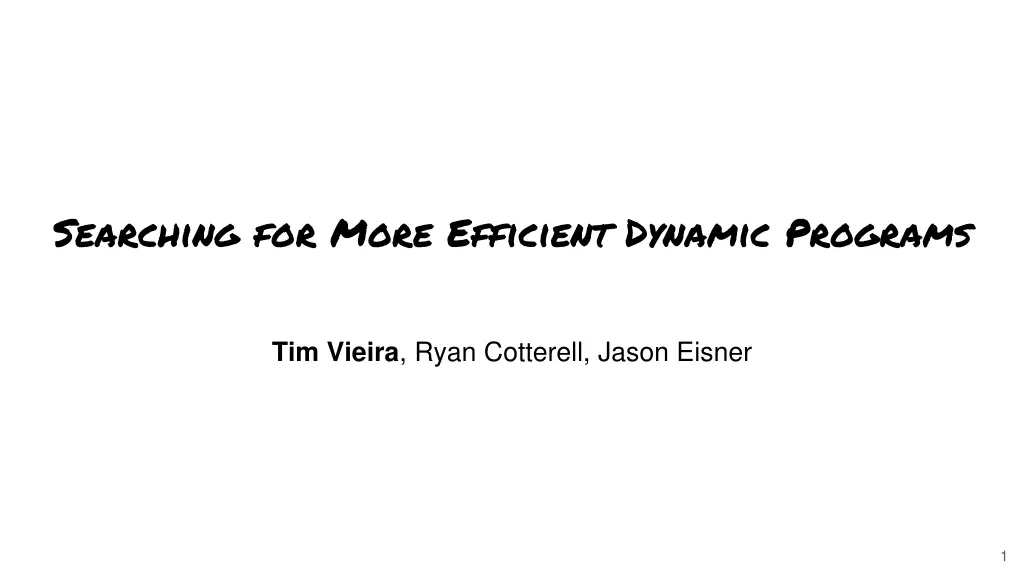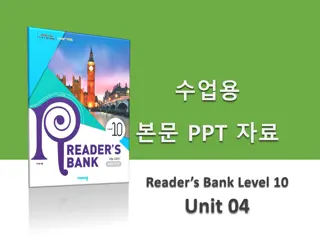
Efficient Dynamic Programming Techniques
Explore more efficient dynamic programming strategies in natural language processing (NLP) algorithms, such as bilexical dependency parsing, split-head-factored dependency parsing, and program optimization through graph search. Discover how to represent algorithms using Dyna, analyze runtime bounds, and apply program transformations for improved efficiency.
Download Presentation

Please find below an Image/Link to download the presentation.
The content on the website is provided AS IS for your information and personal use only. It may not be sold, licensed, or shared on other websites without obtaining consent from the author. If you encounter any issues during the download, it is possible that the publisher has removed the file from their server.
You are allowed to download the files provided on this website for personal or commercial use, subject to the condition that they are used lawfully. All files are the property of their respective owners.
The content on the website is provided AS IS for your information and personal use only. It may not be sold, licensed, or shared on other websites without obtaining consent from the author.
E N D
Presentation Transcript
Searching for More Efficient Dynamic Programs Tim Vieira, Ryan Cotterell, Jason Eisner 1
NLP Loves Dynamic Programming It is the primary tool for devising efficient inference algorithms for numerous linguistic formalisms - finite-state transduction (Mohri, 1997) - dependency parsing (Eisner, 1996; Koo & Collins, 2010) - context-free parsing (Stolcke, 1995; Goodman, 1999) - context-sensitive parsing (Vijay-Shanker & Weir, 1989; Kuhlmann+, 2018) - machine translation (Wu, 1996; Lopez, 2009) 2
Speed-ups Designing an algorithm with the best possible running time is challenging. - Bilexical dependency parsing: O(n ) O(n ) - Split-head-factored dependency parsing: O(n ) O(n ) - Linear index-grammar parsing: O(n ) O(n ) - Lexicalized tree adjoining grammar parsing: O(n ) O(n ) - Inversion transduction grammar: O(n ) O(n ) - Tomita s parsing algorithm: O(G n ) O(G n ) - CKY parsing: O(k n ) O(k n + k n ) We ask a simple question: Can we automatically discover these faster algorithms? 3
Our Approach Cast program optimization as a graph search problem - Nodes are program variations - Edges are meaning-preserving transformations - Costs of each node measures its running time 4
Step 1: Dyna Represent algorithms in Dyna (Eisner et al. 2005), a domain-specific programming language for dynamic programming Example (CKY parsing): X (X,I,K) += (X,Y,Z) * (Y,I,J) * (Z,J,K). Y Z J,Y,Z (X,I,K) += (X,Y) * word(Y,I,K). K I J total += ( S ,0,N) * len(N). X I K 5
Step 2: Runtime Bound From Code Under some technical conditions, the running time of a Dyna program is proportional to the number of ways to instantiate its rules For example, (X,I,K) += (X,Y,Z) * (Y,I,J) * (Z,J,K). We use a simpler analysis O(v ) where v = max(n, k) O(k n ) degree = 6 Why not run the code? WAY TOO SLOW! 6
Step 3: Program Transformations Each program transform maps a Dyna program to another Dyna program with the same meaning and (hopefully) a better running time. We turn to the playbook: Eisner & Blatz (2007) 7
Fold Transform (X,I,K) += (X,Y,Z) * (Y,I,J) * (Z,J,K). O(k n ) or O(v ) (X,I,K) = (X,Y,Z) * (Y,I,J) * (Z,J,K). J,Y,Z (X,I,K) = ( (X,Y,Z) * (Y,I,J))* (Z,J,K). J,Z Y = tmp(X,I,J,Z) (X,I,K) += tmp(X,I,J,Z) * (Z,J,K). tmp(X,I,J,Z) += (X,Y,Z) * (Y,I,J). Unfold Transform O(n k + n k ) or O(v ) 8
Step 4: Search Feed these ingredients to a graph search algorithm We need search because the best sequence of transformations cannot be found greedily. We experimented with beam search and Monte Carlo tree search. 9
Experiments Unit tests 100% Stress tests 10
Summary - Representing algorithms in a unified language allows us systematize the process of speeding them up. - We showed how to optimize dynamic programs with graph search on a program transformation graph. - We found that measuring running time efficiently was essential in order to explore enough of the search graph. 11
Thanks! https://arxiv.org/abs/2109.06966 https://twitter.com/xtimv/status/ 1438611768868225026
X Fold Transform Y Z K I J X (X,I,K) += (X,Y,Z) * (Y,I,K) * (Z,J,K). Y Y Z J,Z creates an intermediate item tmp(X,I,J,Z) K I J X (X,I,K) += tmp(X,I,J,Z) * (Z,J,K). tmp(X,I,J,Z) += (X,Y,Z) * (Y,I,K). Z J,Z Y I J K Generalizes the hook trick 14





